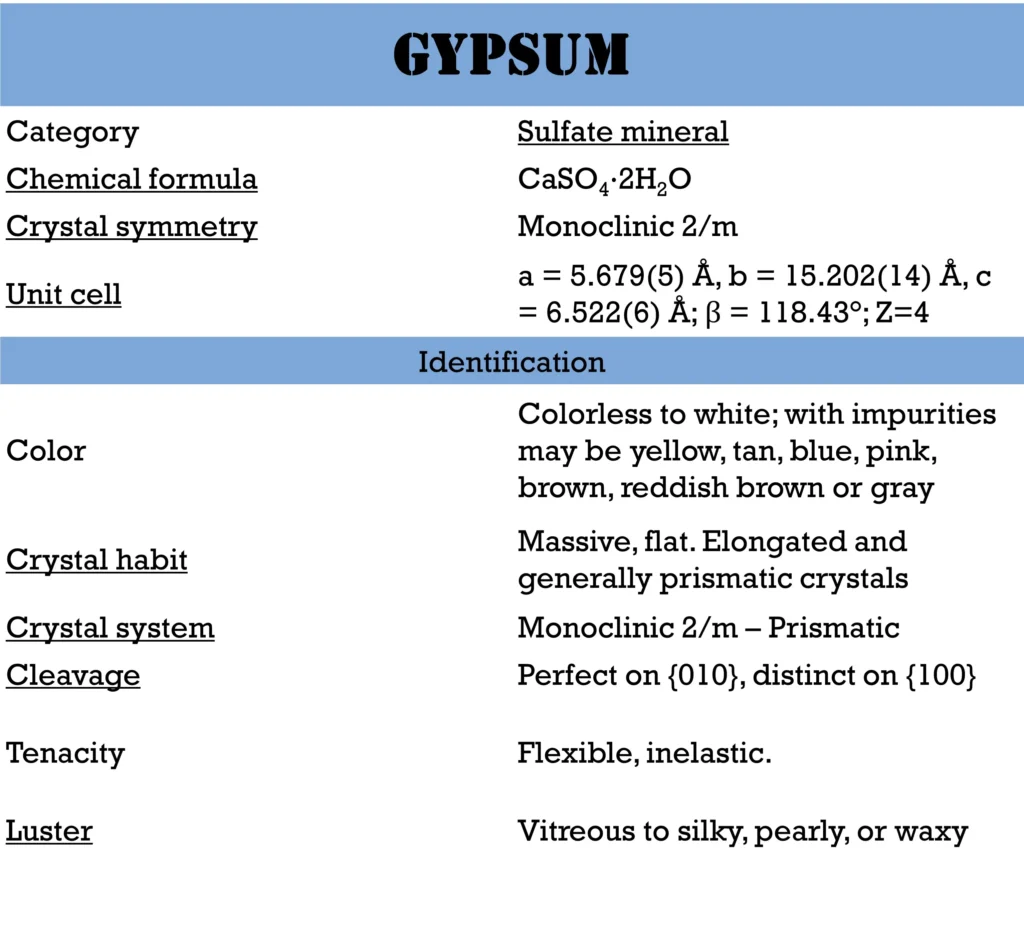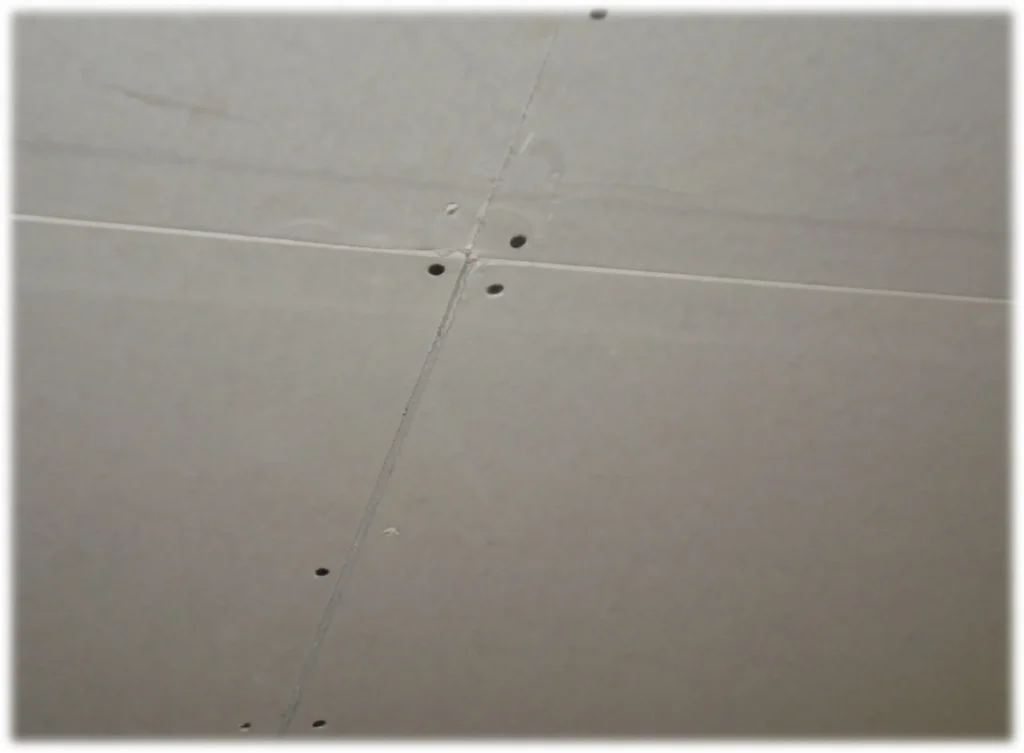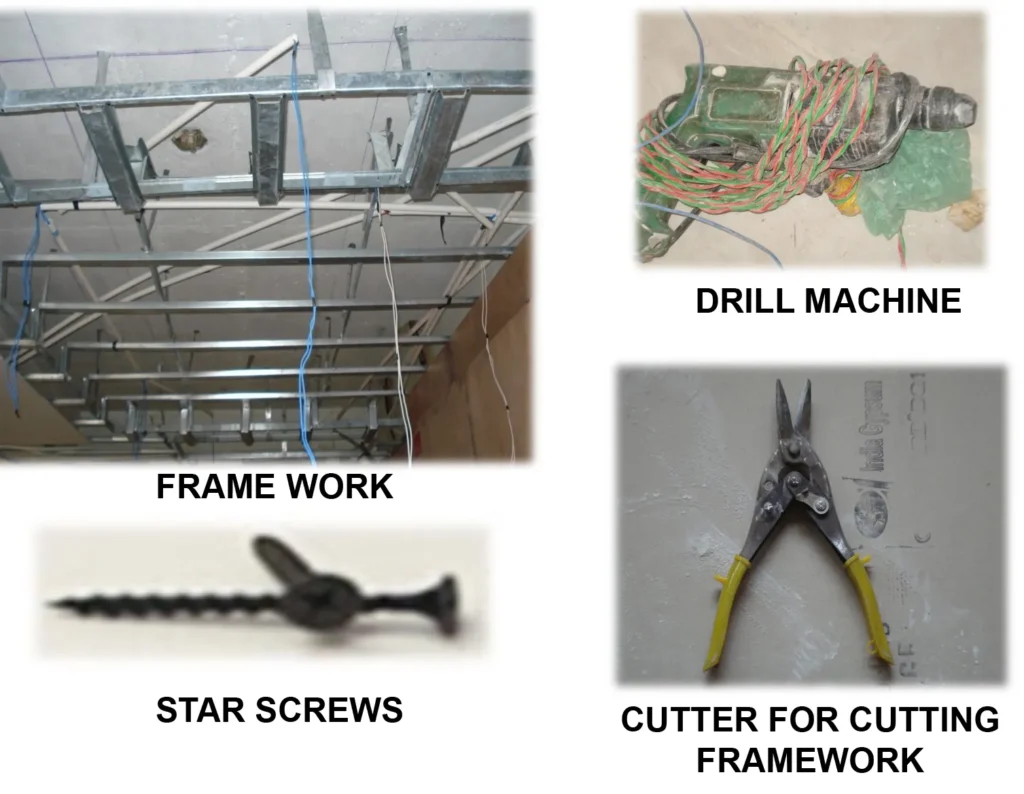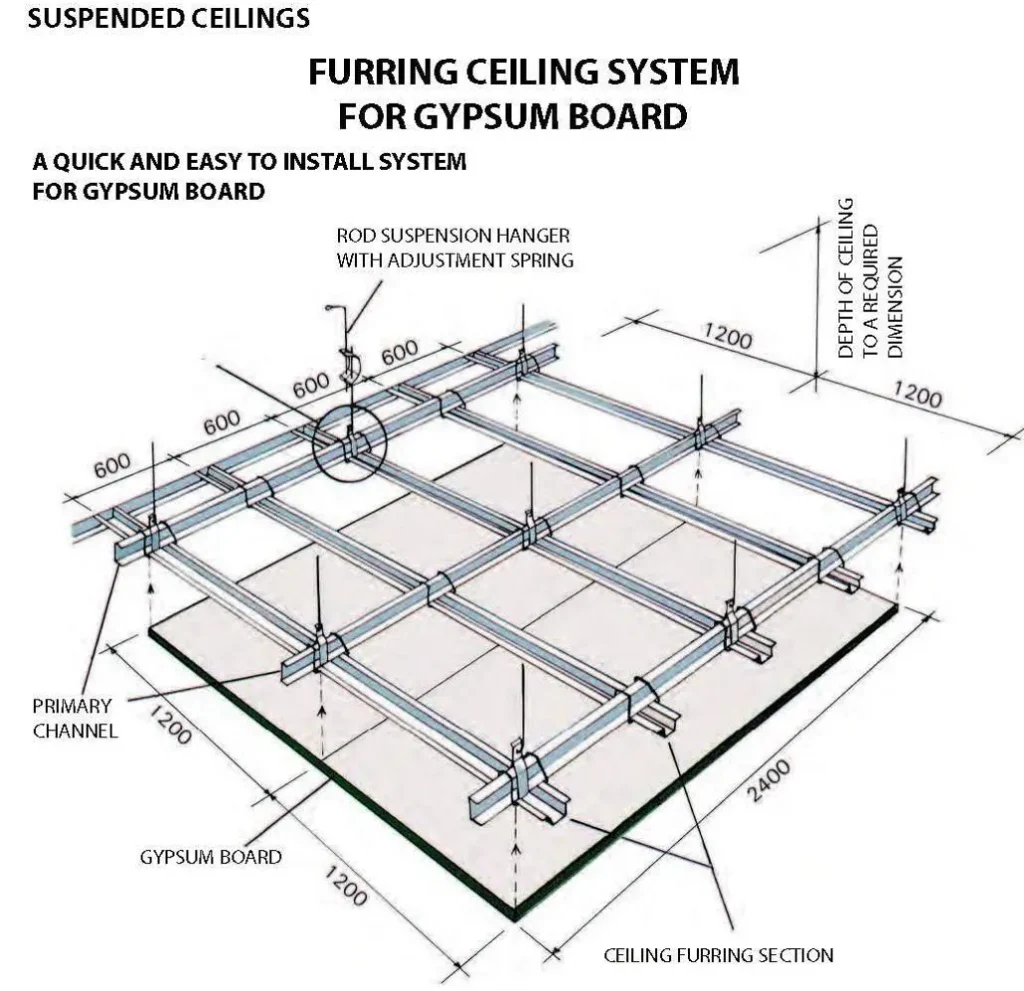If you want to know about the tile flooring or terrazzo and mosaic flooring or introduction of pile foundation, please click the link.
A gypsum ceiling, also known as a plasterboard ceiling or a drywall ceiling, is a type of suspended ceiling that is commonly used in both residential and commercial buildings. It is made up of large, flat panels of gypsum board that are hung from the ceiling joists using metal frames or furring channels.
The advantages of using gypsum ceiling include its ease of installation, fire resistance, sound insulation, and ability to conceal unsightly ceiling elements such as pipes, ducts, and wires. Gypsum ceilings can also be painted or decorated with various finishes to achieve different aesthetic effects.
1) Introduction of gypsum
- Gypsum is a compound of calcium with chemical formula CaSO4·2H2O. Gypsum board also known as drywall is made out of gypsum. A drywall panel is made of a paper liner wrapped around an inner core made primarily from gypsum plaster.
Some other uses of gypsum are: –
- Drywall
- Plaster ingredient.
- Fertilizer and soil conditioner.
- Plaster of Paris (surgical splints; casting moulds; modeling).
- Blackboard chalk.
- A component of Portland cement used to prevent flash setting of concrete.

- Gypsum ceiling are made of gypsum boards of size 4x6ft.
2) Occurrence
- Gypsum is a common, rock-forming mineral, with thick, extensive beds formed by the evaporation of extremely saline waters. It is often associated with other minerals, such as halite and sulfur. It is deposited from lakes, seawater, hot springs, volcanic vapors, and sulfate solutions in geological veins. Hydrothermal anhydrite in veins is commonly hydrated to gypsum by groundwater in near-surface areas.
- It is obtained as assocaited with sedimentary rocks such as halite, calcinite, pyrite and borax.

3) Gypsum plaster
- Plaster of Paris is a type of building material based on calcium sulphate hemihydrate, nominally CaSO4·1/2H2O. It is created by heating gypsum to about 150 °C.
- 2 CaSO4·2H2O → 2 CaSO4·0.5H2O + 3 H2O (released as steam).
- Also known as Plaster-of-Paris, gypsum plaster is a building material that features similar properties to mortar or cement. It is created by heating gypsum, a soft, naturally-occurring mineral, to roughly 300 degrees Fahrenheit (150 °C), and then mixing it with water. The resulting paste hardens as it cools, forming a relatively soft, pliable finished product. Unlike mortar or cement, which dry much harder, gypsum plaster can be sanded or otherwise manipulated once cured, making it a good option for aesthetic, non-load bearing purposes.
4) Gypsum board

- Gypsum board is formed by sandwiching a core of wet gypsum between two sheets of heavy paper or fiberglass mats.
- When the core sets and is dried in a large drying chamber, the sandwich becomes rigid and strong enough for use as a building material, to satisfy specific performance, application, location and appearance requirement.
- Gypsum core is surfaced and edged with various cover materials. Gypsum board is a common manufactured building material used globally for the finish construction of interior walls and ceilings.
- Gypsum board is referred to as dry wall because of its low moisture content.
| Type and edge of gypsum board | Use or description |
| Regular wall board (tapered) | Surface layer for interior walls and ceilings. |
| Insulating (tapered) | Backed with aluminium foil which serves as reflective insulation and a vapour barrier. |
| Moisture resistant (tapered) | Base for ceramic or other nonabsorbent tile in high moisture areas. |
| Waterproof (square) | Similar to above but vinyl surfaced for use in areas subject to direct wetting may be fire rated. |
| Fire resistant (tapered) | Core has a glass fiber and other additives for use in fire resistance rated construction, available with foil backing. |
| Pre- decorated (square or beveled) | Vinyl and tapered surface in various colours, pattern and textures |
| Backing board (square) | Base for multi ply construction- available in regular fire resistant and insulating types |
| Gypsum sheathing | Base for exterior wall finish in wood or metal frame construction- serve as a wind brace and is fire and weather resistant |
| Type of ceiling system | Description | Benefits | Application |
| Gyp board m/f suspended ceiling system | An expensive, non-load bearing system, on which most decorative surface finishes can be applied | Quick and easy to install, light weight, noncombustible, aesthetically appealing and having design flexibility | Multipurpose application are most suitable for offices, banks, comp. Rooms, institution, hospitals, etc. |
| Gyp board m/f suspended ceiling system (load bearing) | A specially designed load bearing ceiling system, ideal for buildings, where movement of workers on top of ceiling cannot be restricted. | Main or cross members are designed for point load up to 60 kgs without deflection. | Suitable for public utility buildings with large areas like airports, hospitals, hotels, institution, auditorium, industrial units, etc. |
| M/f suspended ceiling system (3 hr fire resistant) | Double layer fire line ceiling system, for better thermal insulation, has 12mm thick layer of universal plaster to provide perfectly align surface finish and improved fire resistance up to 175min | Ceiling with a heavy-duty performance, specially improved fire, sound and thermal insulation | Suitable for areas where fire protection and safety of equipment is of prime importance like power projects, chemical industries storing inflammable materials. |
| T Grid ceiling system (600x600mm/600x1200mm) | Conventional modular grid ceiling system is economical and suitable for most types of ceiling panels | Easy to install and dismantle, aesthetically appealing, easy accessibility for services, a wide range of ceiling panels are available providing creative freedom | Suitable for small as well as large ceilings like in offices, institution |
5) Properties
- Due to the unique behaviour of the non-combustible gypsum core, it provides a good fire protection when subjected to high temperature. It is good sound absorbent.
- It has low thermal capacity, thus improving thermal insulation of building.
- Gypsum boards are unsuitable for temperatures above 49 degree Celsius. They can be subjected to freezing temperature without risk of damage.
- It has good dimensional stability.

6) The members of framework for gypsum board ceiling

The framework consists of following elements-
- Perimeter channel
- Soffit cleat or wall angle
- Hanging wire or hanger
- Main T
- cross T or channel`

7) Procedure of laying framework for gypsum board ceiling
- The first member laid for the ceiling is perimeter channel to determine the depth of the false ceiling.
- Soffit cleat is screwed in through fasteners in to concrete ceiling. At the other end of soffit cleat hanger is joined with the help of screws.
- These hangers are joined to U shaped main T through screws. The minimum distance between two main T is 4 feet or 1200mm.
- Main T is laid vertically . Then main T is either clipped to cross T or screwed to cross T.
- Cross T is laid in opposite direction of main T making grid pattern. The minimum distance between two cross T is 1.5 feet or 500 mm. Cross T is basically U in section corners folded outwards.
- Then gypsum board is screwed to channels or cross T with the help of star screw made up of iron. The Gypsum board size used is 6 feet by 4 feet with 25 screws.
- To give finish to the join of two square edge gypsum board firstly we make gap of 6mm between them . then they are filled with pop and reinforced with 50mm wide fibre tape.
- Pop finished plaster is then spread over the join of two boards, leveled and trovelled to a smooth finish to a thickness of 2-5mm.




To install a gypsum ceiling, the first step is to install a metal frame or furring channels onto the ceiling joists. The gypsum boards are then cut to size and fitted into the frames or channels, with the edges of the boards butt-joined or tapered to create a seamless finish. Once the panels are in place, they can be taped, sanded, and finished with a variety of coatings, including paint, textured finishes, or wallpaper.
8) General points regarding gypsum ceiling
- The frame must be structurally sound and rigid enough to prevent the gypsum board from buckling and cracking.
- Little or no water is used in gypsum board application to interior wall and ceiling surfaces.
- It is fairly easy erected to form a smooth surface, monolithic in appearance and finished by painting or applying a paper, vinyl or fabric wall covering.
- Most manufacturers with an environmental concern take back the left over boards from construction sites, and burn them at high temperature to eliminate the paper and bringing back the gypsum to its initial plaster state. Recycled paper is sometimes used during manufacturing
- When used as a component in fire barriers, drywall is a passive fire protection item. In its natural state, gypsum contains the water of crystallization bound in the form of hydrates. When exposed to heat or fire, this water is vaporized, retarding heat transfer
9) Site organisation
Stacking & Storing
- The Ceiling Boards shall be stacked vertically as shown in the diagram. They should not be stacked flat one above the other to avoid breaking of boards. They should be stored in a covered dry place.

Handling
- Gypsum board should always be carried on edge by two men .they should not be carried with their surfaces horizontal.
Cutting
- The cutting of boards and panel should be carried out with a fine toothed saw .Alternatively, gypsum board can be cut by scoring with a sharp knife, snapping the core over a straighten edge and then cutting through the paper on the opposite side.
10) Cost analysis (Not as per the current market)
- Usual size of gypsum board available in market – 4x6ft. Rate – Rs.280
- Rate of members of frame – Rs.65/kg
- Rate of fasteners – Rs.7
- Rate of screw(Star pech) – Rs.120 (1 packet)
- By comparing the pop false ceiling and gypsum board ceiling it is analyzed that pop false ceiling expensive than gypsum board ceiling:-
- Pop false ceiling-Rs.75/sq.ft
- Gypsum board ceiling-Rs.55/sq.ft
Overall, gypsum ceilings offer a cost-effective and practical solution for finishing ceilings in both residential and commercial buildings.
Our Plan Checker has asked for a list of approvals for the conventional suspended ceiling. In searching the various websites, I cannot find any agencies that have given approval for this common method of framing. Can you direct me to an approved system?
p/s give me this paper
Aapne hume bahut achi jankari di uske liye dhanyawad,